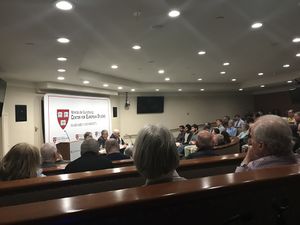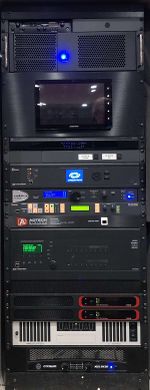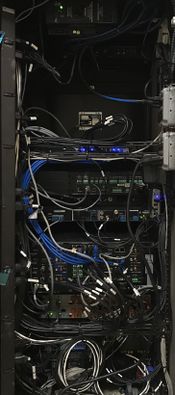Lower Level Conference Room

Lower Level Conference Room, also known as LL1, or LLCR, is the primary room used for large classes, events, and conferences.
A/V
[edit | edit source]The lower level conference room is equipped for video recording, audio capture, voice lift, livestreaming, video conferencing, and projection. Audio mixing is done automatically, but can be adjusted manually from the Crestron panel at the tech station. Video sources, displays, and recordings are also controlled from the same panel.
Note: All wireless audio devices must be registered with Greg Morrow at MTS to prevent crosstalk with other devices nearby.
Equipment
[edit | edit source]| Quantity | Description |
|---|---|
| 1 | Bugs |
| 2 | Samsung DM55E 55" LED Displays |
| 1 | Da-Lite Advantage Electrol Screen with LVC |
| 1 | Sony VPL-FHZ65W 3 LCD Projector with Middle Focus Lens |
| 1 | Crestron TSW‐1060‐B‐S Touch Screens |
| 1 | Crestron TSW-1060-TTW-B-S Table Top Kit |
| 1 | Crestron DM‐MD8X8 Digital Media Switcher |
| 1 | Crestron Pro3 Advanced Control Processor |
| 1 | Extron SMP-351 |
| 1 | Crown XLS 202 2-Channel Power Amplifier |
| 1 | Biamp TesiraFORTÉ DAN‐CI |
| 1 | Biamp TesiraFORTÉ DAN‐VI |
| 2 | Vaddio RoboSHOT 12 HD-SDI PTZ Cameras |
| 1 | Vaddio Premier Precision Controller and 7" Touchscreen |
| 1 | Vaddio AV Bridge |
| 1 | PakEdge SX‐24P 24-Port PoE+ Managed Switch |
| 6 | Shure Microflex MX415LP/C Gooseneck Microphone |
| 2 | Shure Microflex WL185 Omnidirectional Lavalier Microphone with MXW1/O Body Pack |
| 1 | Shure Microflex MXWNCS8 8-Channel Networked Charging Station |
| 1 | Shure Microflex MXWAPT8‐Z10 8-Channel Access Point Transceiver |
| 1 | Listen LT-803-072-01 Stationary 3-Channel RF Transmitter (72 MHz) |
| 4 | Listen LR-400-072 Portable Display RF Receiver (72 MHZ) |
| 8 | Clock Audio C3100‐RF‐CPWH |
| 10 | JBL 24CT |
Wall ports
[edit | edit source]

The A/V system has a number of wall ports to provide input, output, and control functions for the system.
- XLR audio output
- SDI video output
- Unknown USB port
- Cam control for Vaddio controller
- Two AV control ports
- Dante for audio networking
- 3.5mm audio monitor
- DM output
- Touchpanel
- 3.5mm audio input
- USB Human interface device, which will be used for providing I/O to the switcher
- HDMI input for the resident PC
- VGA input for the resident PC
- USB input for HID to Production switcher
Procedures
[edit | edit source]See Event Procedures.
Outside vendors
[edit | edit source]In special cases, an outside vendor may provide the videography for an event. The camera and operator are placed in the back by the center column. An audio feed is provided through an XLR cable which runs through the ceiling and to the center column. An HDMI extender can be used for video capture from the camera. This is HDMI 3 on Bugs. Preferred vendors are MTS and Bay State.
Workarounds
[edit | edit source]When handheld microphones are needed, unplug the lectern microphone XLR and plug it into the Shure wireless microphone receiver. Use the lectern audio input for the microphone. Only one microphone can be used in this manner. Use a wireless gooseneck microphone to replace the lectern microphone if needed.
In case of audio system failure, run an audio cable down the left flank of the room, and set up a PA system in the front of the room.
In case of projection system failure, plug video source directly into the projector in the back of the room.
Deprecated functions
[edit | edit source]Prior to July, 2017, the system was connected to the A/V systems in Hoffmann and Goldman to provide a video and audio stream for overflow. Overflow is now done using a private livestream over YouTube or Facebook.
Elmo was provided for Prof. Kotz's fall-semester economics class. To allow him to switch between his laptop input and the document camera, the Crestron control panel was moved to the panel table for each class. Kotz no longer uses this document camera.
Upgrades
[edit | edit source]- 2008 A/V Upgrade Project
- 2017 A/V Upgrade Project
- Ceiling microphone upgrade project
- Seamless switcher upgrade project
- Step-and-repeat banner upgrade project
- Upholstery and carpet project
Privacy
[edit | edit source]To protect student privacy, the seats located along the back right wall of the room are in a no-film zone. Camera operators must not film this area.
Issues
[edit | edit source]Resident PC input flickering
[edit | edit source]In October, 2019, the screens began flickering when displaying the resident PC input. The side screens and the confidence monitor would go black for a fraction of a second. The flicker was synchronized on all three screens. The tech station screen was never tested. The projector would experience a different artifact. Instead of turning black, a horizontal line of color noise would appear across the top third of the screen. This occurred out of sync with the other screens. The issue did not occur immediately upon powering on the devices. It would also get incrementally more frequent. This implies that the issue may be heat-related. Rod was the source device. The effect was never confirmed with Todd, nor with the laptop input. That semester, Hans-Helmut Kotz was giving two lectures per week, using projection every time. He reported no issues.
Peter Stevens submitted a ticket to AdTech. April Roland created the ticket and Robert O'Shea troubleshot the issue on October 24. Michael Berrio, Stevens, and O'Shea could not replicate the issue. O'Shea was highly confident the issue was an input issue. He said the screens and the projector were probably handling lost signal differently, causing the different effects. O'Shea noted that the output resolution on Rod was lower than 1080p, but the input signal on the Crestron was 1080p. The input chain consists of Rod's software, Rod's HDMI output, HDMI cable, Crestron transmitter, CAT cable, and the Crestron input card. They arrived at the following solution: replace the HDMI cable. If the issue reoccurs, swap out Rod for Todd. If the issue reoccurs, call AdTech to inspect the transmitter, CAT cable, and input card. The devices which may generate heat are the transmitter and the input card.

